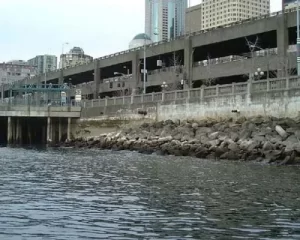

Introduction
The Alaskan Way Viaduct and Sea Wall Utility Mapping Project in Seattle, WA, stands as a significant milestone in the field of utility mapping.
This project leveraged a comprehensive range of techniques, equipment, and concepts honed over the past fifty years, marking a significant advancement in how utility mapping contributes to transportation projects.
The scope of work for the Viaduct project was not only robust but also included detailed characterization data that went beyond the norms for transportation projects.
This case study explores the methodologies employed, the challenges encountered, and the outcomes of this intricate utility mapping project.
Project Overview
Due to the limited space available for utility relocations along the tight corridor, the project required detailed characterization to assist in cost and time estimation for utility owners and ensure continuity of utility service.
This extensive data collection facilitated the creation of a preliminary 3-D model of the utility infrastructure.
Key characterization aspects included quality levels, ownership details, dimensions, and exact locations of utilities such as cables, conduits, vaults, and terminations.
Methodologies Employed
A variety of sophisticated techniques were utilized for detecting and tracing utilities:
- Ground Penetrating Radar (GPR)
- Five Different Pipe and Cable Locators
- Magnetic Tools
- Active and Passive Acoustics
- Terrain Conductivity
- Various Coupling and Insertion Techniques
These methods enabled the project team to map the majority of utilities at Quality Level B (QL-B), with several additional utilities not previously recorded being discovered and mapped accordingly.
Challenges Faced
The project environment presented numerous challenges that required innovative solutions:
- Right-of-Way (ROW) Access Issues and Scheduling: Navigating access restrictions and coordinating schedules posed significant hurdles.
- Heavy Traffic: Managing the impact of high-speed traffic in the southern portion and dense pedestrian and vehicle traffic downtown.
- Security Concerns: Addressing security issues related to the homeless and panhandlers.
- Complex Underground Utility Environment: The dense and complex nature of the underground utility network, including basements and corridors extending beyond building walls, demanded extensive investigative efforts.
- Event Coordination: Synchronizing project activities with sports and other special events to minimize disruptions.
Significant Discoveries and Achievements
The project's execution led to the entry and examination of over 500 utility vaults, with approximately 100 requiring dewatering.
Around 200 test holes were constructed to gather Quality Level A (QL-A) data, providing crucial information for project hydraulic designers.
Notably, the investigation of a 112-inch diameter reinforced concrete pipe (RCP) sewer line uncovered structural concerns, including cracks and evidence of sewage leakage, underscoring the importance of thorough utility mapping in preventing potential infrastructure failures.
Conclusion
The Alaskan Way Viaduct and Sea Wall Utility Mapping Project epitomizes the critical role of advanced utility mapping in modern urban infrastructure projects.
Through the application of a wide array of geophysical techniques and the overcoming of numerous logistical challenges, the project not only achieved its goal of creating a detailed utility map but also set a new benchmark for similar projects in the future.
This case study underscores the necessity of detailed planning, innovative methodology, and collaborative effort in the successful execution of complex utility mapping projects.
